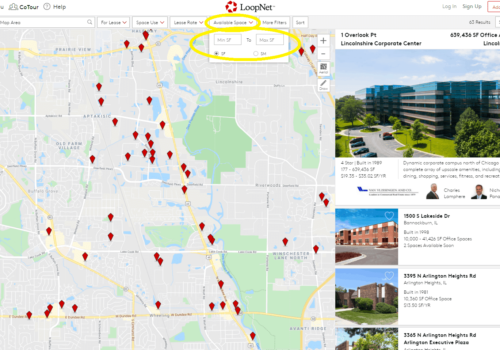
Beyond LoopNet?
LoopNet is the default location for tenants and buyers searching for commercial property in North America. Users flock to the platform due to the size and diversity of available real estate listings. LoopNet provides a simple search engine to sift through a wide variety of potential properties. However, despite the platform’s relative simplicity. We are often hired by clients who spend days searching online with relatively limited success.
So how does a commercial tenant or buyer best find the right property on LoopNet? The key to finding the right space is identifying and categorizing your organization’s commercial real estate needs.
We're Here To Help
Identifying Your Organizational Needs
LoopNet’s vast and diverse property listings are a blessing and a curse. Finding the right property without a plan often wastes vast amounts of time and money. This is especially true for occupiers who determine later in the process that the spaces they are touring do not satisfy their requirements. The most important part of the search is to make a wish list of your commercial real estate wants and must-haves. Without understanding your needs, finding the right space on LoopNet is like finding a needle in a haystack!
Navigating LoopNet’s Property Categories
After establishing your game plan, now it is time to start searching based on your commercial real estate wish list. The first step we recommend is creating a LoopNet query with your must-haves. If your search results return a large number of properties, then you can always start to refine your search further.
Sale or Lease?
LoopNet’s primary categorization of transactions is whether you are looking to buy or rent commercial real estate. Based on your needs, you may be open to potentially both options. Understandably some landlords also list the same properties for sale and lease. As a result, the key is to focus on the transactional category most suited for your needs, and you can always return to pursue additional options.
Asset Classes
LoopNet divides properties into 12 overarching asset classes with multiple sub-classes underneath them. However, for occupiers without experience in the market, some of the classifications overlap and are confusing. Nonetheless, LoopNet’s property classifications help cultivate potentially useful properties.
You can search any number and combination of the above asset classes to narrow down or broaden your property search. Therefore, depending on your knowledge of the market and property type, asset classes can provide a sophisticated tool for finding the right space.


SEARCHING ON LOOPNET BY LOCATION
Location, Location, Location! For commercial real estate, location is often the most crucial factor driving property transactions. Consequently, LoopNet provides users a variety of tools to narrow their searches by location. In the U.S., you can search by state, metro area, “professional submarket,” county, city, zip code, and street/ intersection.
However, the most underutilized search engine feature is the location radius and draw tools. The location radius feature allows searchers to target only properties within a specific number of miles from an address. As a result, the radius tool can be especially helpful for relocations, where it’s essential to stay within the commuting range of employees.
Moreover, the draw tool provides a unique advantage. By allowing users to search within major economic corridors unconstrained by state or municipal boundaries, the draw tool lets searchers hone in to find the exact neighborhood, economic development zone, or businesses park their organization desires.
The complexity of Available Space & Building Size




When searching for available space on LoopNet, it is essential to understand the challenges in adequately measuring commercial real estate. Even after accounting for disparities in usable versus rentable square footage, determining future workspace need is often more art than science. Nonetheless, square footage of available space and building size are two of the best ways to sort workspaces. If you are a startup or new operation, we can work with you on standard metrics.
Available Space
Available space is the size of the area that an occupier rents or purchases in a real estate transaction. As a result, the available space metric is a useful tool for eliminating spaces that are too large or small. However, any broker worth their salt knows the size of an area is only as helpful as its layout. Therefore, after finding spaces around your desired size, it is critical to confirm they will functionally meet your workspace needs.
Building Size
Building size is the area of the entire building located on a property. Since often commercial spaces are built as part of multitenant buildings, available space size and building size can vary drastically. Nonetheless, building size can be a helpful tool to understand the value of an individually listed space. If the property you are investigating is part of a multitenant space, understanding the building’s total size, occupancy, and overall characteristics better inform the occupier of the value of the individual areas located within.
The Price Paradox
Ultimately for most businesses, real estate price is a bottom-line issue. As a consequence, before investing time researching commercial real estate, occupiers want to understand their potential costs and liabilities. LoopNet sought to simplify the cost structure of commercial real estate transactions by boiling down leasing costs to one number. Although data is critical for making wise business decisions, data without context is relatively useless.
As a result, when looking at the “cost” of a lease on LoopNet. It is critical to understand, LoopNet’s pricing is reliant on self-reported costs by landlords. Therefore, we recommend tenants searching in the market always ask for an itemization of costs. Moreover, the best advice we can give is there are no free lunches in the commercial real estate market. Thus, if a number looks suspiciously low, there is probably a good reason why!
Avoiding LoopNet’s “Property Graveyard” Trap
LoopNet’s greatest strength is also the weakness of the platform. As the accuracy of every listing is reliant on listing agents, many properties on the engine are out of date or inaccurate. Most of the inaccuracies on LoopNet are primarily due to neglect. However, some brokers continue to list leased or sold properties for extended periods to increase their chances of drawing in potential clients.
Therefore, to avoid the “property graveyard trap,” it is crucial always to confirm every property listing meets your qualifications with the listing agent. Otherwise, you may waste substantial time and money investigating properties that do not meet your organizational needs.
Beyond LoopNet?
LoopNet is an ideal platform for occupiers beginning their real estate search. However, like any commercial real estate search engine, LoopNet has its limitations. As a result of the simplicity of the platform. LoopNet provides limited insight into a variety of workspaces. Moreover, as the data of the platform is entirely self-reported, users can’t always trust LoopNet’s data is accurate. In addition, LoopNet is the best free property search engine but not every available property is on the platform. Therefore, to get a complete understanding of the market it is always best to diversify your search efforts.
Finding A Commercial Real Estate Broker?
While some businesses complete real estate transactions without a commercial real estate advisor, it may not always be wise. Based on the complexity and demands of your organizational needs, working with an advisor might be best for your business.
A Broker Is More Than A Space Finder
Commercial real estate brokers in the digital age have evolved beyond the traditional role of a space finder. As transactions have become increasingly complex, tenants and purchasers rely on commercial real estate brokers to represent their interests and advise them through all stages of transactions. As commercial brokers, we assist clients by mapping out organizational needs, developing property selection criteria, negotiating the terms of the transaction, supervising workspace construction, and protecting clients’ future and flexibility.
We Open Doors For Our Clients
The physical workspace is more than just the one we can see, touch, taste, and smell. A workplace drives culture. We connect entrepreneurs, corporations, and nonprofits with spaces designed to propel institutional success.
Our sales and leasing team consistently outperforms the market in leveraging industry relationships and local expertise. We use our experience, specialized local knowledge, data analytics, and advanced negotiation tactics to achieve exceptional results.
Whether pursuing flexible or traditional workspace, we provide optimal long-term value!
Our Commercial Real Estate Services
Since 1879, Van Vlissingen and Co. provides quality full-service commercial real estate services to Chicagoland businesses. We are the definitive experts in Lake, McHenry, northern Cook, and DuPage Counties. As tenant, buyer, and property representatives, our team focuses on understanding the unique goals and objectives of our clients. Our commercial real estate agents specialize in relocations, complex renewal negotiations, space expansions, and contractions, as well as land acquisitions, build-to-suits, and investment properties. We work to utilize our years of market experience and strong relationships to maximize your outcome.



